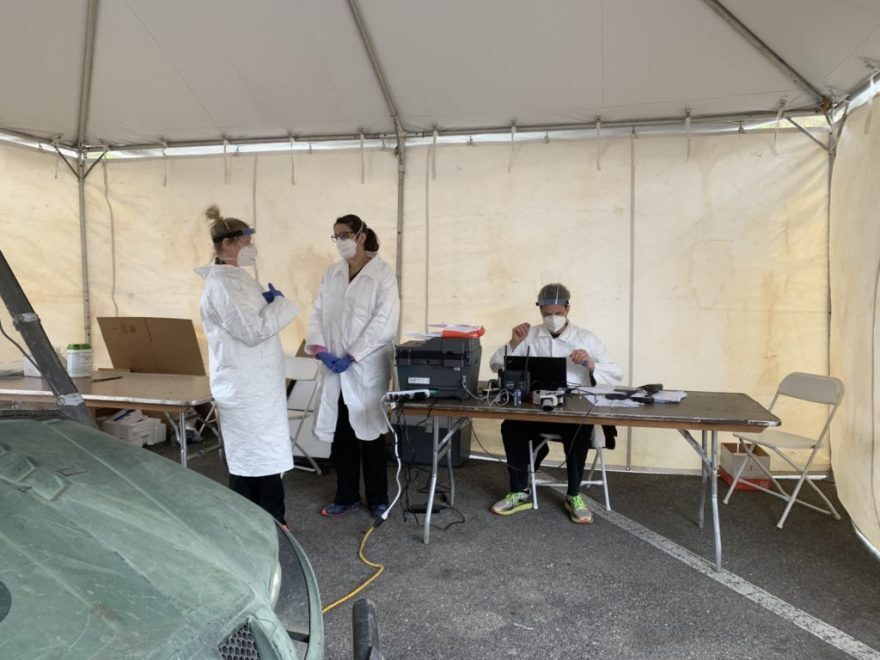The pandemic has swamped health departments. Since August, Ohio Valley health departments have been dealing with a massive surge in cases and that means more testing, contact tracing and phone calls.
Although disease investigation is a core service of health departments, the pandemic has demanded a continual, robust response, placing strain on public health employees.
“It just has totally disrupted anything that we would consider normal or routine. Staff are tired — we’re working 7 days a week,” Athens County Ohio Health Department Administrator Jack Pepper said. “Usually people are happy to see us and … as contentious as vaccines and masking has gotten, the toll it’s taking on my staff is tremendous. We’re really trying hard.”
The pandemic added massive workloads to health departments that were already operating with limited staff and strapped for funding. But public health employees have continued providing services while managing the pandemic, which has led to an increase in demand for harm reduction services like syringe exchanges. The response to the ongoing crises has left public health departments in an even bigger bind as burnout has led to attrition.
Building Trust On a Budget
The Kentucky River District Health Department once had more than 300 employees. Now they have 120. The district includes Knott, Lee, Leslie, Letcher, Owsley, Perry and Wolfe counties. Public Health Director Scott Lockard said the department has earned the trust of the community providing services that people hesitate to seek elsewhere.
“Anonymity and confidentiality is so important,” Lockard said. “We see some people sometimes on their worst days ever, we see people that have contracted a sexually transmitted infection, and want a safe environment where they can get treatment.”
Health departments are at the intersection of communities, and policy, handling everything from mosquito control and septic system inspections to mental health referrals, Lockard said.
Despite the role they play in supporting communities, health departments in the region have faced repeated budget cuts. Since the recession of 2008, the Kentucky River District Health Department has lost a third of its staff.
“Now we're down, basically, here in Kentucky River District, to one nurse per county that is doing WIC services, that we have a nurse practitioner that goes from county to county, and we do family planning clinics, probably in most counties, two to four days a month.”
Seemingly overnight, the world shifted, the NBA cancelled basketball games, states began to lockdown, and health departments took immediate action warning the public about the virus.

Once health departments started handling COVID-19 cases it became the sole focus because it required more resources and staff to do testing and contact tracing.
Lockard said the pandemic has exposed gaps and limitations within health departments.
“If you don't have your basic infrastructure covered, then when you have a surge like this, you can't just throw money after the fact,” Lockard said.
In Graves County, Kentucky every health department employee's job has shifted. The staff does whatever is needed regardless of their job description. Health Department Director Riley Willett said her job has been COVID-focused.
“More so than what it needs to be. But we're in a pandemic, and that's just the way things are right now,” she said. “So every single person here, you know, our clerks, or nurses, or health educators, everyone here, their job has changed greatly.”
Sarah Moyer, Director of Louisville Metro Public Health and Wellness said, as part of the preparedness core service, the health department has a number of plans ready.
So in March 2020, the department used its plans to respond to the pandemic and later vaccine distribution. But the pandemic has lingered for 18 months.
“That’s not sustainable. All of our plans are set up for weeks,” Moyer said. “Like a tornado comes and you go full force for a few weeks. The [Hepatitis] A epidemic was exhausting, but that was a year. It’s just a new form of sustaining that wasn’t part of a plan, so people are burnt out.”
Harm Reduction Services
For years, the Ohio Valley has suffered from some of the highest overdose death rates in the nation. That’s only worsened during the pandemic. Kentucky saw the second highest increase of overdose deaths from February 2020 to February 2021. Ohio death rates increased by 22% and West Virginia saw a 55% increase in deaths.
Prior to the pandemic Moyer said there was an epidemic of deaths of despair— that includes deaths from drug overdoses, suicide and homicide. Moyer said it’s difficult helping the public understand why homicides are included.
“Homicide, I still think the public sees that as a moral failing but, from a medical perspective, it’s no different than suicide or overdose.”
Even as the virus inundated health departments, staff has worked to keep syringe exchanges and harm reduction services available. Since 2017, the Kentucky River Health District has exchanged more than 1.2 million needles. Jefferson County distributed more than 13,000 doses of Naloxone from March 2020 through February 2021.
Moyer said the mental health team has distributed twice as many doses of Naloxone during the pandemic compared to the year before.
Since October 2017, Lockard said the needle exchange program has served 2,226 people.
“And we have exchanged 1,239,000 needles,” Lockard said. “We have been really fortunate, in that our harm reduction services have continued on throughout the pandemic.”
Marshall County doesn’t have a syringe exchange program. But, Pitts is glad Marshall County does.
“Because when those folks come in, they're getting clean needles, but at the same time, they're getting some education,” he said. “They're being referred to some resources, and so you never know, you never know how far that might go.”
Graves County has seen an increase in needle exchanges. It’s the only syringe service program in far western Kentucky.
“But, also, through that we've had people that might not have been vaccinated get vaccinated,” Willet said.

Burn Out
All of the health departments interviewed by the Ohio Valley ReSource discussed the strain and burnout the pandemic has placed on employees.
Pitts said the pandemic has driven people out of public health.
“When you lose one or two staff, that might not sound like a lot,” Pitts said. “I'm in search now to try to find a registered nurse. And you know, and that's 50% of my working nurses in the clinic only had two.”
On top of that, the hiring process may take months.
As health departments continue handling COVID-19 cases, Jack Pepper said Athens County Health Department employees continue trying to prevent death and the spread of disease.
“It’s not been the easiest 18 months, but we are not malicious people here at the health department. We just are trying to keep our communities as safe as we possibly can,” he said.
New Laws
On Sept. 22, Director of Public Health transformation at the Kentucky Department for Public Health, Jan Chamness, gave an update on the progress of House Bill 129, referred to as public health transformation, before the Kentucky Legislature.
“The main reason to transform Kentucky's public health system is because what we're doing now is just not working,” Chamness said. “This is the latest report from the county rankings of America's Health Rankings that show Kentucky's health behaviors as 48 and health outcomes as 46.”
According to the same report, in 2020, West Virginia ranked 45th in health outcomes and 44th in health behaviors. Health outcomes in Ohio were ranked 39th and 41st in health behaviors.
The new law has directed all public health departments to focus on specific services like disease investigation and environmental health. Lockard said it has also stabilized pensions and provided equitable funding so the same services would be available to anyone in the state.
But funding wasn’t provided for that legislation.
“Small rural health departments like us, and Kentucky River district, Cumberland Valley District Health Department, we're not going to be able to meet our pension obligation and deliver the services that’s required for our community without that funding of public health transformation.”
Liam Niemeyer, Kaitlin Thorne and Ryan Van Velzer contributed to this story.





